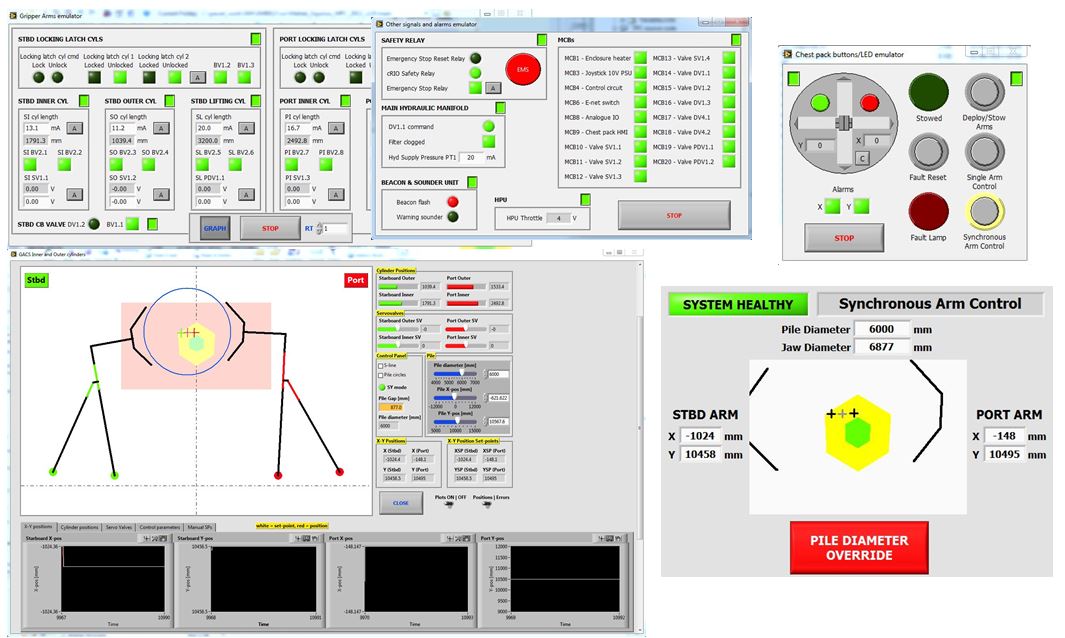Software Services
LabVIEW and Hardware in the Loop (HIL) Testing
With LabVIEW, transitioning from a PC-based emulator to Hardware in the Loop (HIL) testing, where the application software runs on a real-time target like CompactRIO, can be relatively straightforward. There are several options for this.
- Processor in the Loop Testing - The system emulator remains on the PC and interfaces with the real-time target using emulated I/O. This approach validates the real-time implementation, such as assessing CPU load, memory usage, and specific FPGA features.
- Full HIL Testing - Sensors and actuators are emulated electrically, potentially running the software emulator on a second real-time processor interfacing with real IO modules. This approach provides a more rigorous test of the application software, with its value depending on the criticality of determinism and dynamic performance in the final system.
In addition to functional testing, HIL testing can be used to obtain initial tuning parameters for feedback controllers and to test the controller tuning procedures intended for the real system.
Using Simulations During Control Software Development
Download PDF VersionEvaluation of Design Options and Performance Using Dynamic Simulation
Early in the design process, simulations are invaluable for evaluating various design options, assessing potential performance, and exploring different system features. Typically, this involves dynamic simulations to address fundamental uncertainties around performance and validate the feasibility of designs. However, logic-based functions can also be simulated at this stage to mitigate risks in certain aspects of the design.
We use both MATLAB/Simulink and LabVIEW CD&SIM to build such simulations. Additionally, we can convert models between these development environments to enable model integration or reuse. Monte Carlo simulations can be useful for exploring performance across a random, wide range of operating scenarios.
Virtual Commissioning using Software-based Emulators ("Software in the Loop")
During the development of the main control software application, a software emulation of the physical system can be built to replicate operating modes and test various aspects, e.g. fault detection and handling tests by injecting faults as defined in the System Test Specification.
Typically, this emualtion may be logic-based to sufficiently replicate full operations from start-up, normal operations, to shutdown. Only simple dynamics may be needed unless performance assessment remains critical at this stage.
In addition to testing the implemented software, such a software emulator can be linked to the user HMI screens and emulated buttons and lamps to review operational aspects with the end-users or customers. This provides a valuable early review and helps build confidence with the final end-users.
LabVIEW's capability to run the same code on a PC or a real-time target minimises overhead when transitioning between a PC-based emulator and the real-time target for HIL testing. Early definition of the software architecture to facilitate switching between emulated I/O and real I/O is beneficial.
Extensive software testing, whether during development or for later revisions or bug fixes, can be performed without needing access to the physical system or real-time target. This is particularly helpful for certain applications where testing on the real system is often limited, for logic-based systems and slower sample rate control systems as it is not fully deterministic.

Emulator for the 70-ton Gripper Arm Control Software Development
Operator Training On Simulators
Training on a simulator enables operators to learn normal operations and how fault conditions manifest and are handled within a safe simulation environment. Developing such a training simulator can be as simple as re-using the software-based emulator with well-defined instructions.
More on our training simulator services.
More Information